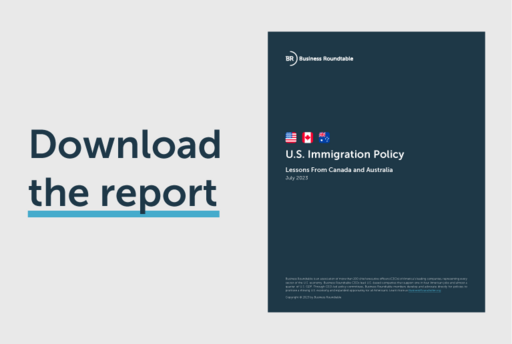U.S. Immigration Policy: Lessons From Canada and Australia
Immigrants built the United States and are central to its future. America has a successful tradition as a nation of immigrants, and U.S. immigration policy should reflect that important fact. Higher levels of immigration would enhance economic growth and make dealing with the aging of America’s workforce and population easier. Thus, the United States needs an immigration system that admits more immigrants and temporary visa holders at different skill levels to fill gaps in the labor market and fuel the country’s growth and a prosperous future.
Examining the immigration policies of Canada and Australia, Business Roundtable finds that U.S. immigration policy puts our nation at a competitive disadvantage. Both Canada and Australia: make it easier for international students and the spouses of visa holders to work than under U.S. policy; impose no annual limits on high-skilled temporary visas, which allows their systems to adapt to labor market needs; provide for much greater speed and transparency in processing business visas than the United States; and do a better job than the United States in addressing the demographic challenges of aging populations. Canada and Australia also use point-based systems that have been cited by some in the United States as a direction for its immigration system, but a closer examination presents many cautions for policymakers in considering a point-based system for the United States.
This report is a follow-up to the 2015 Business Roundtable State of Immigration report, which examined the U.S. immigration system in relation to other advanced economies to determine which nations maintained “the best immigration policies to promote economic growth.” In that report, Business Roundtable found that the United States ranked 9th out of the 10 countries analyzed, behind Germany, Australia, Singapore and other nations.
For this analysis, Business Roundtable analyzed Canadian and Australian immigration laws and interviewed individuals with practical knowledge of how the immigration systems of the two countries work. The goal of the research was to determine what lessons policymakers could gain from Canada and Australia that could best be applied to the U.S. immigration system.
